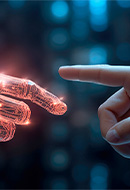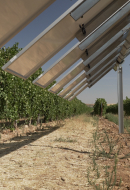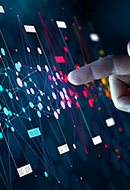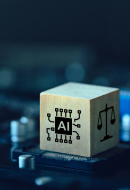What is Artificial Intelligence?
Are we aware of the challenges and main applications of Artificial Intelligence?
Artificial intelligence has long since abandoned the realm of science fiction and is quietly sneaking into our lives. Although still at a very early stage, is laying the foundation to lead a revolution comparable to that generated by the Internet. Its applications in multiple sectors — such as health, finance, transport and education, among others — have prompted the European Union to develop its own Robotics Laws.

Artificial Intelligence... yes or no?
Would you like someone to tell you about it? Listen to this article. For those who want to change the world.
Artificial Intelligence (AI) is the combination of algorithms formulated for the purpose of creating machines that have the same skills as a human being. This is a technology that still seems to be distant and mysterious, but one which has been a constant presence in our day-to-day lives for some years now.
Types of Artificial Intelligence
The computer science experts Stuart Russell and Peter Norvig differentiate between various types of artificial intelligence:
 Systems that think like humans
Systems that think like humans
Automate activities such as decision-making, problem-solving and learning. One example is artificial neural networks.
 Systems that act like humans
Systems that act like humans
Are computers that perform tasks in a similar manner to people. This is the case of robots.
 Systems that think rationally
Systems that think rationally
Attempt to emulate human rational, logical thought, in other words, researching ways to make machines that are capable of understanding, reasoning and then acting. Expert systems are included in this group.
 Systems that act rationally
Systems that act rationally
Ideally, they attempt to imitate human behaviour in a rational manner, like intelligent agents.
Practical applications of Artificial Intelligence
The AI is present in the facial detection function of mobile phones, in virtual voice assistants such as Siri from Apple, Alexa from Amazon or Cortana from Microsoft, and it is integrated into our everyday devices through bots (short for robots) and mobile apps such as: Lyli External link, opens in new window., a digital personal shopper; Parla
External link, opens in new window., a digital personal shopper; Parla External link, opens in new window., conceived to help us with language learning; Ems
External link, opens in new window., conceived to help us with language learning; Ems External link, opens in new window., designed to make the arduous task of finding new flooring a little bit more bearable; and Gyant
External link, opens in new window., designed to make the arduous task of finding new flooring a little bit more bearable; and Gyant External link, opens in new window., a virtual assistant on Facebook that issues medical "diagnoses". The aim of all of these is to make people's lives easier.
External link, opens in new window., a virtual assistant on Facebook that issues medical "diagnoses". The aim of all of these is to make people's lives easier.
Advances in AI are already driving the use of big data on account of its ability to process massive amounts of data and provide communication, commercial and business advantages that have led it into the position as the essential technology for the coming decades. Regardless of the field — transportation, education, health or culture — no sector will be able to resist its charms.
The main practical applications of artificial intelligence
-
Virtual personal assistants
We will live with interactive chatbots who can suggest products, restaurants, hotels, services and shows according to our search history.
-
Climate
Fleets of drones capable of planting one billion trees per year to combat deforestation, unmanned submarine vehicles to detect leaks in oil pipelines, smart buildings designed to reduce energy consumption, etc.
-
Agriculture
Specific platforms that use predictive analysis to improve agricultural yields and warn of any adverse impact to the environment.
-
Finance
Smart technologiescan help banks detect fraud, predict market patterns and advise customers on transactions.
-
Education
It will let you know if a student is about to cancel their registration, suggest new courses and create personalised offerings to optimise learning.
-
Commercial
AI will make it possible to create salesforecasts and choose the right product to recommend to the client. Companies like Amazon userobots to identify whether or not a book will be successful, even before its launch.
-
Logistics and transportation
It will be useful for avoiding collisionsor traffic jams, as well as for optimisingtraffic flow. Tesla has developed a system in which, when one of its cars uses a route for the first time, it shares the information with the rest.
-
Health
Chatbots already exist which ask us about our symptoms in order to make a diagnosis. Data collection generates patterns that help with identifying genetic factors which are susceptible to developing a disease.

Green artificial intelligence
Green AI has emerged as one of the main mitigation pathways.
-R. San Juan Moya-

History of artificial intelligence
Discover its history and how we at Iberdrola are taking advantage of this technology.

Evolution of Artificial Intelligence
Find out how AI has evolved over the years.

Types of AI Algorithms
Learn about the types of algorithms used by Artificial Intelligence.
Iberdrola, at the forefront of Artificial Intelligence
Artificial intelligence (AI) is a technology that is already part of Iberdrola's business, and its different applications have become a fundamental resource for the company. Below, discover how we use AI in our activities and its impact on our production and our customers.
 Commercial
Commercial
Artificial intelligence systems today represent a very effective way to achieve automation in the area of purchasing or management of household resources. One of these solutions is the Advanced Smart Assistant, a digital platform launched by Iberdrola with which our customers can easily and automatically manage the consumption of smart electrical devices.
With this innovative product, deployed in the Amazon Web Services (AWS) cloud and developed at Iberdrola's Innovation Middle East Centre using AI services, users can also shift consumption to the cheapest tariff hours, maximising electricity savings in their homes.
 Renewables
Renewables
Automatic learning, also known as Machine Learning, is a discipline in the field of artificial intelligence that provides any system with the ability to identify patterns from previously collected data. These information-laden algorithms allow computers to perform specific tasks autonomously, without the need for programming.
One of the main applications of machine learning is in the field of weather forecasting, since, with this technique, machines can obtain repeating data or information related to meteorological processes quickly and effectively. A clear example of this is the MeteoFlow system developed by Iberdrola Renovables
This is Iberdrola's own computer system that is capable of estimating how much the Group's various renewable energy facilities will produce based on weather forecasts. From information on the wind for wind farms or solar radiation for photovoltaic plants, for example, MeteoFlow prepares production forecasts that subsequently favour the sale of the energy produced, the maintenance of the facilities and the preparation of reports.
 Distribution and transmission grids
Distribution and transmission grids
The integration of data analysis using artificial intelligence can significantly improve the processes and operation of smart grids. Thanks to the digitalisation of the grid, everything related to the operation of smart grids and energy supply can be managed quickly and remotely, allowing for frequent preventive maintenance, detection of anomalies and anticipation of dangerous situations.
The six laws of robotics proposed by the European Parliament
This incredibly fast-paced emergence of AI and robotics in our society has forced international organisations to think about the need to establish regulations that regulate their use and employment, with the purpose of preventing any potential problems that might arise in the future.
- Robots must be designed with opt-out mechanisms (kill switches) to avoid dangerous situations.
- A robot may not harm humanity. Robotics has been expressly conceived to help and protect people.
- The development of an emotional connection between humans and robots will not be allowed.
- An insurance policy will be mandatory for larger units. Owners of robots will be held liable for material damage caused by their robots.
- The rights and obligations of robots will be classified by the corresponding laws.
- Robots and machines will pay social security contributions. Their entry into the labour market will have an impact on the labour force of many companies. Robots must pay taxes to subsidise unemployment benefits.
Both technologies are already changing the world and the figures are proof of this. The US consulting services firm Gartner estimated that the market for AI may reach 127 billion dollars in 2025, a figure far greater than the 2 billion in 2015. The United States and China will take the lead in investments. The consequence is that, according to the International Monetary Fund (IMF), AI will kill 85 million jobs in five years, but create 97 million in return.
And although there are voices like that of the Swedish philosopher from the University of Oxford, Nick Bostrom, who anticipates that: "There is a 90% chance between 2075 and 2090 that there will be machines as intelligent as humans", or that of Stephen Hawking, who projects that machines will completely surpass humans in less than 100 years, the truth is that far from rendering us obsolete, AI will make us more efficient and allow us to perform actions that we could never have undertaken due to their complexity. Can you imagine exploring parts of the universe that are totally hostile to humans? One day this will be possible thanks to AI.







